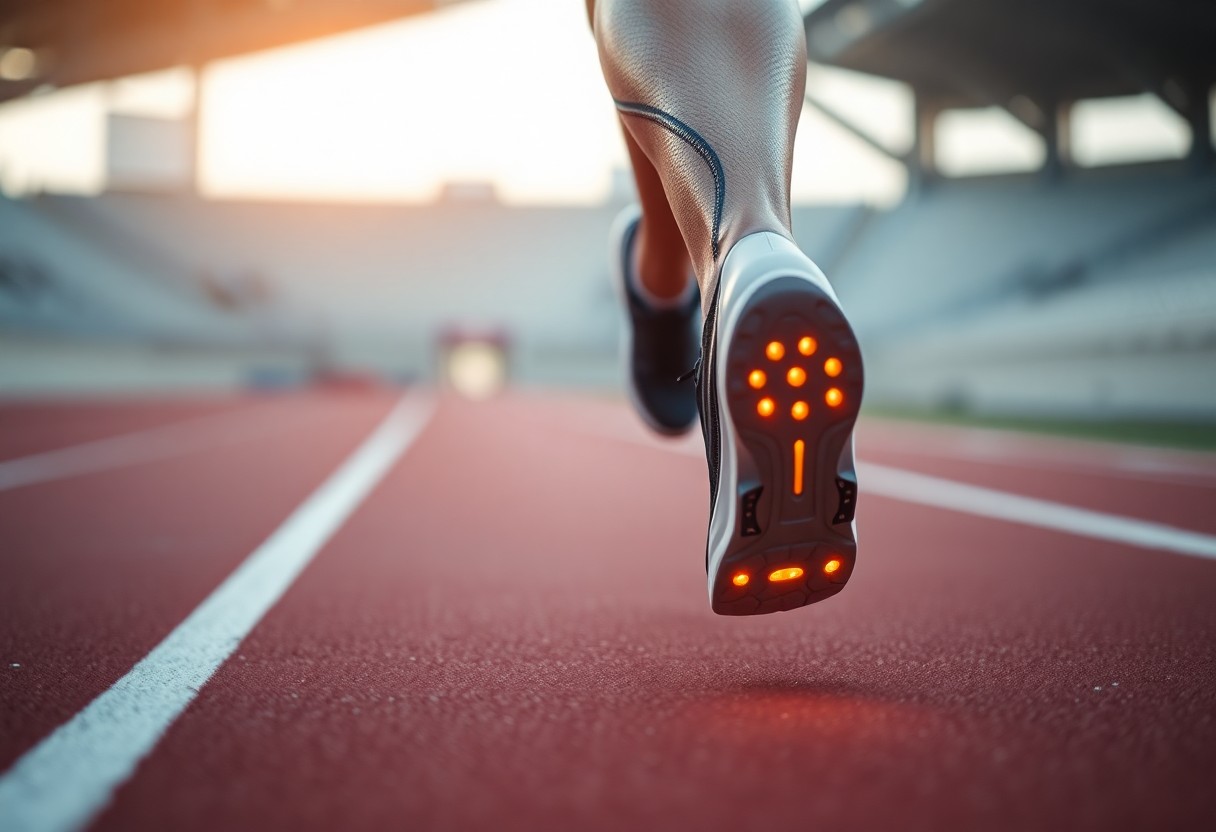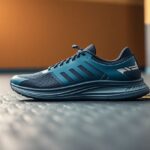
Delve into the groundbreaking advancements in running footwear technology that have dramatically reshaped the performance optimisation landscape for endurance athletes, providing unparalleled opportunities for improvement.
Performance optimisation in endurance running has been transformed by advanced footwear technology, presenting you with remarkable chances to enhance your athletic capabilities. You will learn how innovative shoe designs can significantly lower your metabolic expenditure and boost running economy. Integrating carbon fibre plates and revolutionary midsole materials, these shoes deliver exceptional energy return mechanisms that could reduce your oxygen consumption by as much as 4%. Whether you are a seasoned professional or an enthusiastic amateur, gaining insights into these biomechanical advancements can empower you to make well-informed choices about your running gear and potentially enhance your race times.
 Continue reading to explore the intricate mechanics of running footwear designed to elevate performance:
Continue reading to explore the intricate mechanics of running footwear designed to elevate performance:
Maximising Performance: Energy Return Mechanisms in Advanced Running Shoes
The technology behind advanced running shoes utilises sophisticated biomechanical principles to enhance the transfer of energy during movement. Innovative design features work together to minimise metabolic expenditure, establishing a complex system that maximises running efficiency through meticulous material engineering and geometric configurations. By concentrating on the mechanics of energy return, these shoes provide runners with a substantial advantage in both performance and stamina, enabling them to undertake longer runs with less fatigue and greater endurance.
Unpacking the Dynamics of Carbon Fibre Plates
Carbon fibre plates utilise precise geometric engineering to redirect kinetic energy throughout the running motion. Optimal curvature angles ranging from 12° to 15° facilitate maximum energy storage and return, with finite element modelling revealing energy return efficiency of up to 93% in prototype designs. These engineered plates act like a spring mechanism, reducing muscular work during the toe-off phase, allowing runners to conserve energy over longer distances, which leads to improved endurance and performance.
Evaluating TPU vs. EVA in Midsole Technology Innovations
The choice of material has a profound impact on shoe performance, with thermoplastic polyurethane (TPU) emerging as the superior option for midsole technology. Comparative analyses highlight TPU’s considerable benefits in energy return and impact absorption, providing runners with enhanced biomechanical efficiency across a variety of running conditions. The decision between TPU and EVA foam is vital for athletes who aim to optimise their performance and reduce the risk of injuries during training and competition.
| Energy Return | 18% higher in TPU |
| Oxygen Consumption Reduction | 2.4% lower with TPU |
A thorough investigation into midsole materials reveals intricate performance characteristics. TPU shows improved resilience when compared to traditional EVA foam, maintaining consistent mechanical properties after thousands of compression cycles. Runners benefit from more reliable energy return, diminished fatigue, and enhanced performance in long-distance scenarios thanks to advanced material science innovations, which can greatly affect their overall training outcomes and results in competition.
| Impact Absorption | TPU absorbs 37% more force |
| Rebound Elasticity | 89% maintained across 50,000 cycles |
 Continue as we investigate how advanced footwear technology influences metabolic efficiency:
Continue as we investigate how advanced footwear technology influences metabolic efficiency:
Identifying Who Gains the Most from Advanced Footwear in Terms of Metabolic Efficiency
The impact of advanced footwear technology is not uniform across all runners. Gains in metabolic efficiency show considerable variation among different demographic groups, with factors such as gender, age, and individual biomechanics playing critical roles in performance enhancement. Research has unveiled intricate patterns of metabolic response, indicating that the advantages of super shoes extend beyond mere performance metrics to encompass complex physiological adaptations that are unique to each runner’s biomechanical profile.
Investigating Gender-Specific Enhancements in Performance
Female runners experience a 3.2% improvement in metabolic power, while males see a 4.2% increase, indicating complex neuromuscular adaptations. Data on pelvic kinematics reveals a 14% greater reduction in hip adduction angle among females using advanced footwear, which may clarify the subtle differences in metabolic gains observed between genders. Recognising these differences can help tailor training programmes and footwear selections to optimise performance benefits for each gender.
Exploring Age-Related Advantages and Endurance Performance
Masters athletes aged 40 and above exhibit a 2.8% reduction in oxygen cost when using super shoes, a likely compensation for decreased tendon elasticity. Analysis of tibial loading shows a 12% reduction in cumulative stress per kilometre for older runners, suggesting significant benefits in injury prevention and maintenance of performance. These findings underscore the pivotal role of advanced footwear technology in prolonging the competitive lifespan of older athletes.
The age-related benefits of advanced footwear technology transcend basic performance metrics. Biomechanical studies indicate that older runners experience substantial adaptations due to compensatory mechanisms. Altered muscle recruitment patterns and reduced tendon stiffness interact with shoe technology to form a unique profile of performance enhancement. Specifically, the energy return mechanism of the carbon plate seems to counteract age-related biomechanical inefficiencies, thereby potentially extending the competitive running careers of older athletes by alleviating the physiological limitations commonly associated with aging.
Continue reading to discover more about the implications of advanced footwear technology on injury risks:
Analysing the Influence of Running Footwear on Injury Risk
Advanced footwear technology introduces complex biomechanical interactions that necessitate a detailed examination of possible injury risks. Runners must weigh the trade-offs between performance enhancement and physiological adaptation. Longitudinal studies indicate subtle yet significant alterations in muscle recruitment patterns, joint loading, and proprioceptive feedback when transitioning to high-performance running shoes, highlighting the importance of a balanced approach to training and recovery.
Injury Assessment: The Price of Enhanced Performance
Research in biomechanics indicates a 9% increase in strain rates of the Achilles tendon among users of super shoes during high-intensity training. Plantar pressure mapping reveals a 22% increase in loading on the forefoot compared to conventional trainers, particularly on challenging terrains such as downhill running. These findings imply that while metabolic efficiency may be enhanced, runners must adopt targeted strength and adaptation protocols to minimise potential injury risks and ensure long-term health as athletes.
Modifying Training Protocols for Optimal Gait Adaptations
Your biomechanical response to advanced footwear necessitates strategic adjustments in your training methodology. Gait retraining is essential to optimise the unique energy return mechanisms inherent in carbon-plated shoes. Runners need to focus on developing neuromuscular patterns that align with the shoe’s biomechanical design, potentially decreasing the risk of injury while maximising performance gains.
A comprehensive strategy for gait adaptation involves multifaceted approaches to seamlessly integrate advanced footwear technology. Biomechanical analysis indicates that runners typically require approximately 6 to 8 weeks of progressive training to fully acclimatise to the distinctive mechanical properties of super shoes. This adaptation phase encompasses targeted eccentric strengthening protocols, modified interval training techniques, and careful monitoring of lower limb biomechanics. Professional athletes and serious runners can greatly benefit from periodic 3D gait analysis to observe subtle changes in their movement patterns, thereby ensuring optimal integration of advanced footwear technology with their unique biomechanical characteristics.
 Explore the future of footwear technology and its implications for runners:
Explore the future of footwear technology and its implications for runners:
Anticipating Future Innovations in Running Footwear Technology
Emerging technologies are on the verge of revolutionising running shoe design, pushing the limits of biomechanical efficiency and performance optimisation. Cutting-edge research centres on personalised solutions that adapt to individual biomechanics, utilising advanced materials, computational modelling, and integrated sensor technologies to develop a new generation of intelligent footwear that caters to elite athletes.
Transforming Footwear Design with 3D Printed Midsoles
Lattice structure optimisation algorithms now facilitate precise regional stiffness variations that correspond to individual foot pressure maps. Prototype testing shows a 5.1% increase in metabolic savings compared to mass-produced models, with computational design enabling unprecedented customisation of midsole geometries to enhance energy return and reduce biomechanical stress. This innovative approach guarantees that every runner can achieve optimal performance tailored to their specific physical attributes.
Integrating Smart Technology for Enhanced Performance Monitoring
Innovative sensor technologies are transforming running shoes into sophisticated devices for tracking performance. Real-time ground reaction force feedback systems can decrease oxygen costs by 1.9% through micro-adjustments in cadence, offering runners immediate biomechanical insights during both training and competition. These advancements are vital for athletes seeking to fine-tune their technique and performance metrics.
Advanced sensor integration marks a significant leap in performance monitoring technology. Multi-axis accelerometers, pressure-sensitive matrices, and embedded microprocessors now gather intricate biomechanical data with exceptional precision. These intelligent systems evaluate gait mechanics, impact forces, and energy expenditure in real-time, furnishing runners with detailed insights into their movement patterns. Machine learning algorithms can now forecast potential injury risks, optimise training loads, and recommend personalised technique modifications based on extensive movement analysis, transforming running shoes from mere equipment into active tools for performance optimisation.
In conclusion, gain a deeper understanding of the evolving landscape of advanced footwear technology in endurance running:
Embracing the Evolution of Advanced Footwear Technology
In summary, you have explored the transformative nature of advanced footwear technology within the realm of endurance running. Your knowledge now encompasses how pioneering design features, such as carbon plates and high-performance midsole materials, can substantially decrease metabolic costs and boost running efficiency. By leveraging scientific insights, you can see that these shoes offer much more than incremental gains—they signify a pivotal shift in athletic performance. Investing in such technology could lead to enhanced running economy, diminished energy expenditure, and optimised biomechanical responses across a wide range of athletic demographics.
The Article Biomechanical Efficiency of Advanced Footwear Technology: Metabolic Cost Reduction and Performance Enhancement in Endurance Running appeared first on My Shoes Finder.
The Article Biomechanical Efficiency in Advanced Footwear for Runners Was Found On https://limitsofstrategy.com






One response
It’s fascinating how technology in running footwear has evolved so rapidly and is now intertwined with the performance of athletes at all levels. I’ve noticed during my own training that the right pair of shoes not only feels more comfortable but seems to improve my efficiency as well. The way carbon fibre plates and advanced midsoles work together to enhance energy return is a game-changer, especially for those of us aiming to push our limits in endurance events.